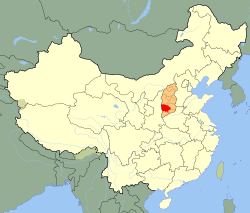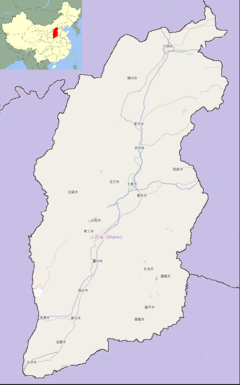Linfen
|
Linfen 临汾市 |
|
|---|---|
| Prefecture-level city | |

Drum Tower of Linfen
|
|
 Location of Linfen City in Shanxi and the PRC |
|
| Location of the city centre in Shanxi | |
| Coordinates: 36°05′N 111°31′E / 36.083°N 111.517°ECoordinates: 36°05′N 111°31′E / 36.083°N 111.517°E | |
| Country | People's Republic of China |
| Province | Shanxi |
| County-level divisions | 17 |
| Municipal seat | Yaodu District |
| Government | |
| • Type | Prefecture-level city |
| • CPC Linfen Secretary | Yue Puyu (岳普煜) |
| • Mayor | Liu Yuqiang (刘予强) |
| Area | |
| • Prefecture-level city | 20,275 km2 (7,828 sq mi) |
| • Urban | 1,304 km2 (503 sq mi) |
| • Metro | 1,304 km2 (503 sq mi) |
| Elevation | 452 m (1,483 ft) |
| Highest elevation | 2,346.8 m (7,699.5 ft) |
| Lowest elevation | 385.1 m (1,263.5 ft) |
| Population (2010 census) | |
| • Prefecture-level city | 4,316,612 |
| • Density | 210/km2 (550/sq mi) |
| • Urban | 944,050 |
| • Metro | 944,050 |
| Time zone | China Standard (UTC+8) |
| Postal code | 041000 |
| Area code(s) | 0357 |
| Licence plates | 晋L |
| Administrative division code | 141000 |
| ISO 3166-2 | CN-14-10 |
| Website | linfen |
| Linfen | |||||||||
| Traditional Chinese | |||||||||
|---|---|---|---|---|---|---|---|---|---|
| Simplified Chinese | |||||||||
|
|||||||||
| Jin Prefecture Jinzhou |
|||||||||
| Traditional Chinese | |||||||||
| Simplified Chinese | |||||||||
|
|||||||||
| Pingyang Commandery Pingyang |
|||||||||
| Traditional Chinese | |||||||||
| Simplified Chinese | |||||||||
|
|||||||||
| Transcriptions | |
|---|---|
| Standard Mandarin | |
| Hanyu Pinyin | Línfén |
| Wade–Giles | Lin-fen |
| Transcriptions | |
|---|---|
| Standard Mandarin | |
| Hanyu Pinyin | Jìnzhōu |
| Wade–Giles | Chin-chou |
| Transcriptions | |
|---|---|
| Standard Mandarin | |
| Hanyu Pinyin | Píngyángjùn |
| Wade–Giles | P‘ing-yang Chün |
Linfen is a prefecture-level city in southern Shanxi province, People's Republic of China. It is situated along the banks of the Fen River. It has an area of 20,275 square kilometres (7,828 sq mi) and according to the 2010 Census, a population of 4,316,612 inhabitants of which 944,050 live in the built-up (or metro) area made up of Yaodu urban district. GDP of Linfen ranked second in Shanxi Province It was known as Pingyang () during the Spring and Autumn period. In 2006, the American Blacksmith Institute listed Linfen as one of the ten most polluted cities in the world.
Prior to 1978, Linfen was famous for its spring water, greenery and rich agriculture and therefore nicknamed "The Modern Fruit and Flower Town". Since then it has been developing into a main industrial centre for coal mining, which has significantly damaged the city's environment, air quality, farming, health and its previous status as a green village.
Linfen is named for the Fen River. Its former names include Jin, Jinzhou, and Pingyang(平阳).
Chinese archeologists have claimed that Yao's capital was located in Linfen, a confirmation of local legend responsible for the name of the city's Yaodu District. So, Linfen city is the earliest capital of China.
The area was the center of the marchland and duchy of Jin, named for the Jin River (). The duchy collapsed in the 4th century BC but gave its name to a Chinese princely title used as the dynastic name of the Sima clan. Jin Prefecture was centered on the town, which took its name as Jin and Jinzhou. Later, it was renamed Pingyang Commandery, which was also adapted as the name for its chief town. The Xiongnu Chanyu Liu Cong made Pingyang his residence in the fourth century. "He kept court at Pingyang in [Shanxi] and ruled over central and southern [Shanxi], over [Shaanxi] (except for the Han basin), northern [Henan] (except for Kaifeng), southern [Hebei], and northern [Shandong]." In the 10th century, the city's walls were considered "fortified beyond approach".
...
Wikipedia

